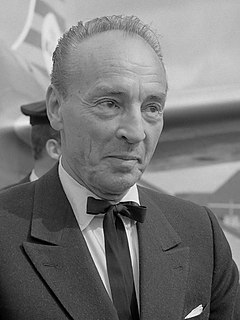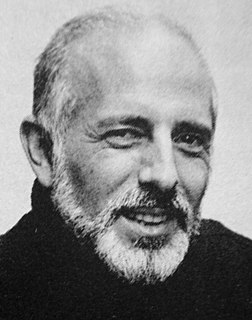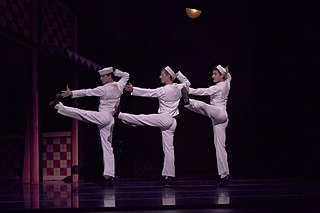
George Balanchine was a Georgian-American ballet choreographer who was one of the most influential 20th-century choreographers. Styled as the father of American ballet, he co-founded the New York City Ballet and remained its Artistic Director for more than 35 years. His choreography is characterized by plotless ballets with minimal costume and décor, performed to classical and neoclassical music.

Jerome Robbins was an American choreographer, director, dancer, and theater producer who worked in classical ballet, on stage, film, and television.
The American Ballet was the first professional ballet company George Balanchine created in the United States. The company was founded with the help of Lincoln Kirstein and Edward Warburg, managed by Alexander Merovitch and populated by students of Kirstein and Balanchine's School of American Ballet. Having failed to mount a tour, American Ballet began performing at the "Old Met." After being allowed to stage only two dance performances, Balanchine moved the company to Hollywood in 1938. The company was restarted as the American Ballet Caravan and toured North and South America, although it too folded after several years.
Christopher Peter Wheeldon OBE is an English international choreographer of contemporary ballet.
Jewels is a three-act ballet created for the New York City Ballet by co-founder and founding choreographer George Balanchine. It premièred on Thursday, 13 April 1967 at the New York State Theater, with sets designed by Peter Harvey and lighting by Ronald Bates.

Apollo is a neoclassical ballet in two tableaux composed between 1927 and 1928 by Igor Stravinsky. It was choreographed in 1928 by twenty-four-year-old George Balanchine, with the composer contributing the libretto. The scenery and costumes were designed by André Bauchant, with new costumes by Coco Chanel in 1929. The scenery was executed by Alexander Shervashidze, with costumes under the direction of Mme. A. Youkine. The American patron of the arts Elizabeth Sprague Coolidge had commissioned the ballet in 1927 for a festival of contemporary music to be held the following year at the Library of Congress in Washington, D.C.

Miami City Ballet is an American ballet company based in Miami Beach, Florida, led by artistic director Lourdes Lopez. MCB was founded in 1985 by Toby Lerner Ansin, a Miami philanthropist. Ansin and the founding board hired Edward Villella, former New York City Ballet principal dancer to be the founding artistic director.
John Taras was an American ballet master, repetiteur, and choreographer.
The balcony scene from Romeo and Juliet was staged by Sean Lavery, assistant to the ballet master in chief at New York City Ballet to Prokofiev's Romeo and Juliet (1934–1940). The premiere took place 24 February 1991 at the New York State Theater, Lincoln Center.
Tango is a ballet made by New York City Ballet co-founder and founding choreographer George Balanchine to Stravinsky's Tango (1940) arranged 1953 by the composer. The premiere took place June 10, 1982, as part of City Ballet's Stravinsky Centennial Celebration at the New York State Theater, Lincoln Center.
Rachel Rutherford is a former soloist with New York City Ballet.

Fancy Free is a ballet by Jerome Robbins, subsequently ballet master of New York City Ballet, made on Ballet Theatre, predecessor of American Ballet Theatre, to a score by Leonard Bernstein, with scenery by Oliver Smith, costumes by Kermit Love and lighting by Ronald Bates. The premiere took place on Tuesday, 18 April 1944 at the old Metropolitan Opera House, New York. The NYCB premiere took place Thursday, 31 January 1980. Fancy Free was the inspiration for a successful musical, On the Town, and a portion of the score was also used in the opening scenes of Alfred Hitchcock's Rear Window.
Lewellyn Farr Christensen was a ballet dancer, choreographer and director for many companies. He was largely associated with George Balanchine and the San Francisco Ballet, which he directed from 1952–1984. Other companies Christensen was a part of include Ballet Caravan, directed by Lincoln Kirstein, and Ballet Society, directed by Kirstein and Balanchine.
The Chairman Dances is a ballet made by New York City Ballet ballet master in chief Peter Martins to John Adams' eponymous music from 1985. The music was originally written for Adams' opera, Nixon in China, but not used in production: the scene is that in which Mao Zedong dances with his future bride, movie star Chiang Ch'ing. The premiere took place on 14 May 1988, as part of City Ballet's American Music Festival at New York State Theater, Lincoln Center, with scenery and costumes by Rouben Ter-Arutunian, and lighting by Mark Stanley.
Union Jack is a ballet made by New York City Ballet co-founder and founding choreographer George Balanchine to traditional British tunes, hornpipe melodies and music-hall songs, ca. 1890–1914, adapted by Hershy Kay. The premiere took place on 13 May 1976, at the New York State Theater, Lincoln Center, to honor British heritage in the United States its bicentennial with costumes by Rouben Ter-Arutunian, original lighting by Ronald Bates and current lighting by Mark Stanley. At the finale the ensemble spells out "God Save the Queen" in semaphore code and the Union Jack unfurls. Principal dancer Jock Soto included an excerpt from Union Jack in his farewell performance in June 2005.
Tschaikovsky Piano Concerto No. 2, originally called Ballet Imperial, is a ballet in three movements made by New York City Ballet's co-founder and founding choreographer George Balanchine for his earlier company, American Ballet Caravan, to the version of Peter Ilyitch Tchaikovsky's Piano Concerto No. 2, originally composed in 1879–80, but later revised by Alexander Siloti. The ballet was given a preview performance on 29 May 1941 at the Little Theater of Hunter College in New York City. The premiere took place on 25 June 1941 at Teatro Municipal, Rio de Janeiro.
Who Cares? is a ballet made by New York City Ballet's co-founder and founding choreographer George Balanchine to songs by George Gershwin in an orchestration by Hershy Kay. The premiere took place on Saturday, February 7, 1970, at the New York State Theater, Lincoln Center with costumes by Barbara Karinska and lighting by Ronald Bates; it was at first performed without décor but from November 1970 with scenery by Jo Mielziner.
Ballo della Regina is a one-act neoclassical ballet choreographed by George Balanchine to music by Giuseppe Verdi. It is a set of variations set to ballet music that Verdi cut from Act 3 of the original 1867 version of his opera Don Carlos. Its premiere performance was on 12 January 1978, by the New York City Ballet at New York State Theater in Lincoln Center.
The Gershwin Piano Concerto is a ballet made on New York City Ballet by its ballet master Jerome Robbins to George Gershwin's 1925 Concerto in F. The premiere took place on February 6, 1982 at the New York State Theater, Lincoln Center, N.Y.